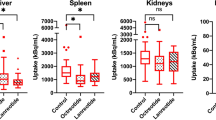Abstract.
As scintigraphy with [111In-DTPA0]octreotide has become a standard technique in analysing somatostatin receptor-receptor positive lesions such as neuroendocrine tumours, a logical next step is peptide receptor radionuclide therapy (PRRT). Initial studies on PRRT were performed with high doses of [111In-DTPA0]octreotide, and recently other radionuclides coupled to other somatostatin analogues have been used for this purpose. However, the dose delivered to the kidney is a major dose-limiting factor. Amino acid solutions have previously been used to reduce renal uptake of radioactivity, but these solutions have some disadvantages, i.e. their hyperosmolarity and their propensity to cause vomiting and metabolic changes. In this study we tested various amino acid solutions in patients receiving [111In-DTPA0]octreotide PRRT in order to assess their safety and their capacity to inhibit the renal uptake of radioactivity. Patients served as their own non-infused control. Renal radioactivity at 24 h following the injection of [111In-DTPA0]octreotide was inhibited by (1) a commercially available amino acid solution (AA) (21%±14%, P<0.02), (2) by 25 g (17%±9%, P<0.04), 50 g (15%±13%, P<0.04) or 75 g of lysine (44%±11%, P<0.001) and (3) by a combination of 25 g of lysine plus 25 g of arginine (LysArg) (33%±23%, P<0.01). Fluid infusion alone (500, 1,000 or 2,000 ml of saline/glucose) did not change renal uptake of radioactivity. In patients studied with 75 g of lysine (Lys75) and LysArg, serum potassium levels rose significantly. Maximal potassium levels were within the toxic range (6.3, 6.7 and 6.8 mmol/l) in three out of six patients infused with Lys75, whereas with LysArg the highest concentration measured was 6.0 mmol/l. Electrocardiographic analysis did not reveal significant changes in any of the patients. Vomiting occurred in 50% of patients infused with AA, but in only 6% of patients receiving no amino acid infusion (controls) and 9% of patients receiving LysArg. We conclude that co-infusion of Lys75 or LysArg results in a significant inhibition of renal radioactivity in PRRT, allowing higher treatment doses and thus resulting in higher tumour radiation doses. Because Lys75 produced serious hyperkalaemia, it is not suitable for clinical use. LysArg, however, is effective in offering renal protection in PRRT and is safe.
Similar content being viewed by others
Author information
Authors and Affiliations
Additional information
Electronic Publication
Rights and permissions
About this article
Cite this article
Rolleman, E.J., Valkema, R., de Jong, M. et al. Safe and effective inhibition of renal uptake of radiolabelled octreotide by a combination of lysine and arginine. Eur J Nucl Med 30, 9–15 (2003). https://doi.org/10.1007/s00259-002-0982-3
Received:
Accepted:
Issue Date:
DOI: https://doi.org/10.1007/s00259-002-0982-3




